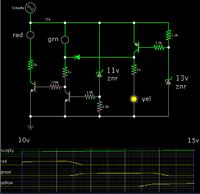Audioguru
Advanced Member level 7
- Joined
- Jan 19, 2008
- Messages
- 9,458
- Helped
- 2,151
- Reputation
- 4,302
- Reaction score
- 2,008
- Trophy points
- 1,393
- Location
- Toronto area of Canada
- Activity points
- 59,734
Re: Battery over discharge & other indicator circuit
R5 adjusts the output voltage of the LM317 as is shown in its datasheet. R1 is 0.5 ohms so when the current in it that is overcharging the battery creates 0.65V across it then the charging current is limited to 0.65V/0.5 ohms= 1.3A that is MUCH too high for your little battery that charges at about 0.1A.
No.sir you said "the 4th one does but its high current does not match your little battery"
In explanation below the diagram , an adjustment option to get required charging current by means of R5 (1k) is there . .
& too my battery current rating is 1 Amp. & 1.0 Ah.
R5 adjusts the output voltage of the LM317 as is shown in its datasheet. R1 is 0.5 ohms so when the current in it that is overcharging the battery creates 0.65V across it then the charging current is limited to 0.65V/0.5 ohms= 1.3A that is MUCH too high for your little battery that charges at about 0.1A.

